
Browse an alphabetical list of photographs. These historical images portray people, places, and events before, during, and after World War II and the Holocaust.
<< Previous | Displaying results 651-700 of 2641 for "Photo" | Next >>
Defendant Julius Streicher in his prison cell at Nuremberg. For his influential role in inciting hatred and violence, the International Military Tribunal at Nuremberg indicated Streicher on count four, crimes against humanity. Streicher was found guilty and sentenced to death. He was hanged on October 16, 1946.
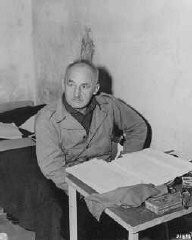
Defendant Julius Streicher, editor of the racist newspaper Der Stuermer. Streicher was one of the MT brought 24 leading German officials charged by the International Military Tribunal at Nuremberg.
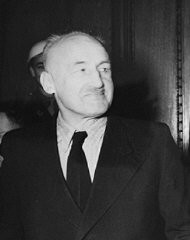
On September 15, 1947, defendant Paul Blobel pleads not guilty during his arraignment at the Einsatzgruppen Trial. Blobel was the commander of the unit responsible for the massacre at Babi Yar (near Kiev). He was convicted by the military tribunal at Nuremberg and sentenced to death. Blobel was hanged at the Landsberg prison on June 8, 1951.
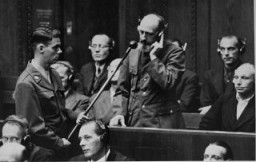
Among the many ironies of the International Military Tribunal was that the defendants were accorded that which they had denied their opponents: the protection of the law and a right to due process. Here, defendant Walther Funk, former German Minister of Economics, speaks with his defense attorney, Dr. Fritz Sauter, in a visitation room at Nuremberg.
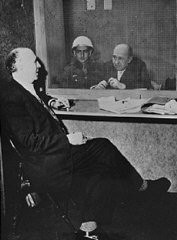
Defendant Wilhelm Keitel, former Chief of the German Armed Forces, in his Nuremberg prison cell.
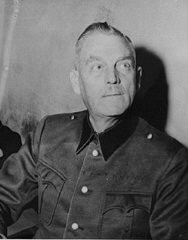
The defendants rise as the judges enter the courtroom at the International Military Tribunal trial of war criminals at Nuremberg.
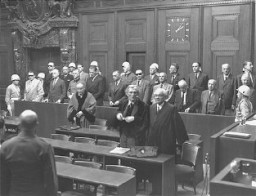
Defendants Wilhelm Keitel (left), Ernst Kaltenbrunner (middle), and Alfred Rosenberg (right), talk during a recess in the proceedings at the International Military Tribunal trial of war criminals at Nuremberg. Nuremberg, Germany, 1945–1946.
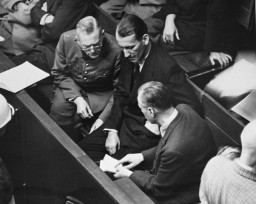
Birds-eye view of the fenced-in cell block where defendants in the International Military Tribunal war crimes trial were imprisoned. Nuremberg, Germany, between November 20, 1945, and October 1, 1946.
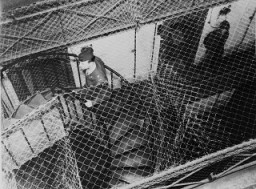
View of the defendants in the dock at the International Military Tribunal trial of war criminals at Nuremberg. November 1945.
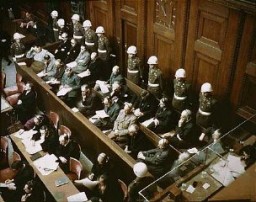
A group of the 19 men accused of committing atrocities at the Dora-Mittelbau concentration camp, located near Nordhausen, during their war crimes trial. Dachau, Germany, September 19, 1947.
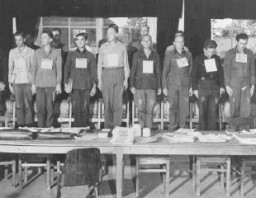
Visitors view the "Degenerate Art" exhibition (Entartete Kunst) at the Munich Hofgarten in July 1937. Works by Lovis Corinth and Franz Marc are visible, among others.

Delegates to the Evian Conference, where the fate of Jewish refugees from Nazi Germany was discussed. US delegate Myron Taylor is third from left. France, July 1938.
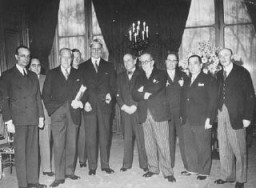
A post marked with Soviet symbols along the demarcation line between German- and Soviet-occupied Poland.
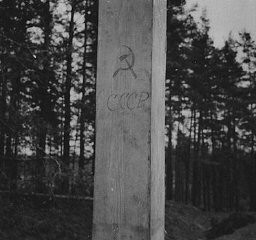
Two German sentries stand guard at Augustow on the demarcation line between Soviet- and German-occupied Poland. September 1939.
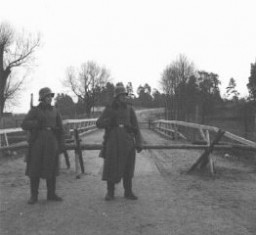
Defendant John Demjanjuk comments on documents being viewed on a large screen in court. Jerusalem, Israel, July 27, 1987.
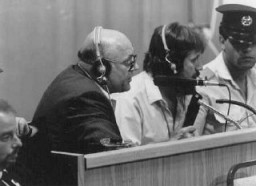
Defendant John Demjanjuk crosses his heart upon hearing the pronouncement of his death sentence. Jerusalem, Israel, April 25, 1988.

Survivors of the Dachau concentration camp prepare to move a corpse during a demonstration of the cremation process at the camp. Dachau, Germany, April 29–May 10, 1945. This image is among the commonly reproduced and distributed, and often extremely graphic, images of liberation. These photographs provided powerful documentation of the crimes of the Nazi era.
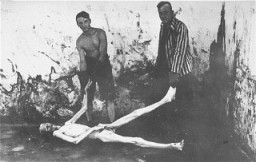
Survivors of the Dachau concentration camp demonstrate the operation of the crematorium by pushing a corpse into one of the ovens. Dachau, Germany, April 29–May 10, 1945. This image is among the commonly reproduced and distributed, and often extremely graphic, images of liberation. These photographs provided powerful documentation of the crimes of the Nazi era.
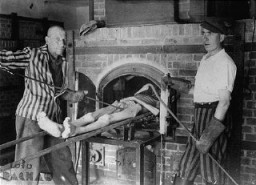
Survivors of the Dachau concentration camp demonstrate the operation of the crematorium by pushing a corpse into one of the ovens. Dachau, Germany, April 29–May 10, 1945. This image is among the commonly reproduced and distributed, and often extremely graphic, images of liberation. These photographs provided powerful documentation of the crimes of the Nazi era.

Survivors of the Dachau concentration camp demonstrate the operation of the crematorium by preparing a corpse to be placed into one of the ovens. Dachau, Germany, April 29–May 10, 1945. This image is among the commonly reproduced and distributed, and often extremely graphic, images of liberation. These photographs provided powerful documentation of the crimes of the Nazi era.
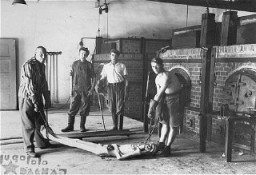
Survivors of the Dachau concentration camp demonstrate the operation of the crematorium by dragging a corpse toward one of the ovens. Dachau, Germany, April 29–May 10, 1945. This image is among the commonly reproduced and distributed, and often extremely graphic, images of liberation. These photographs provided powerful documentation of the crimes of the Nazi era.
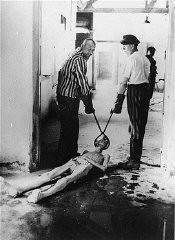
A survivor shows US Generals Eisenhower, Patton, and Bradley how inmates at the Ohrdruf camp were tortured. Ohrdruf, Germany, April 1945.
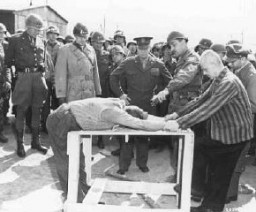
Zionist group gather with banners outside the Deggendorf displaced persons camp to demonstrate for Jewish immigration to Palestine. Deggendorf, Germany, 1945-49.
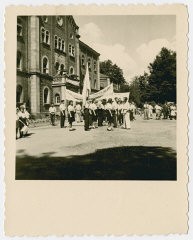
A public demonstration is held on the Unter den Linden in Berlin on November 9, 1918. On this day, Kaiser Wilhelm II abdicated the throne after a recent naval mutiny in Kiel inspired widespread revolution. © IWM Q 88164
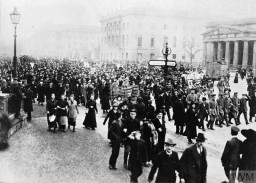
A US soldier inspects piles of Nazi books, including Mein Kampf, that were found in a German school. As part of their denazification policies, Allied authorities purged German libraries, bookstores, and schools of Nazi propaganda. Aachen, Germany, May 2, 1945.
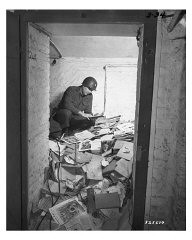
Dental technicians prepare molds at the Neu Freimann displaced persons (DP) camp, circa 1945–1949. Neu Freimann had its own dental treatment facility. The photographer, Jack Sutin, lived at the camp with his family and worked as a camp administrator and photojournalist.
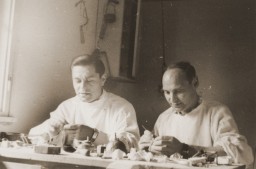
Deportation of German Jews from Hanau to Theresienstadt. Hanau, Germany, May 30, 1942.
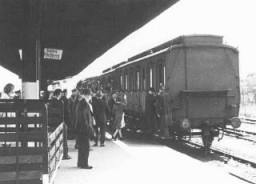
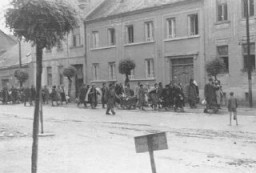
Jewish women, children, and the elderly await deportation at the railroad station in Koszeg, a small town in northwestern Hungary. Koszeg, Hungary, 1944.

Deportation of Jews from the Kovno ghetto to a work camp. Lithuania, 1942.
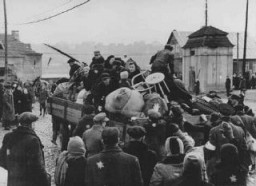
Jewish families with bundles of belongings during deportation from the Kovno ghetto in Lithuania to Riga in neighboring Latvia. Kovno, Lithuania, 1942.
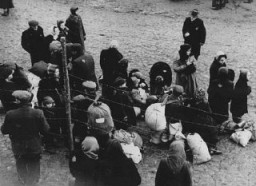
Deportation from the Krakow ghetto at the time of the ghetto's liquidation. Krakow, Poland, March 1943.
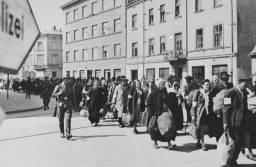
Jews from the Lodz ghetto are forced to transfer to a narrow-gauge railroad at Kolo during deportation to the Chelmno killing center. Kolo, Poland, probably 1942.
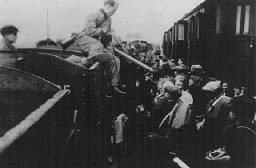
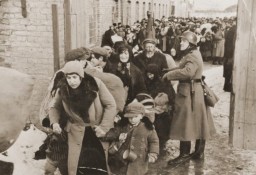
Under guard, Jewish men, women, and children board trains during deportation from Siedlce to the Treblinka killing center. Siedlce, Poland, August 1942.
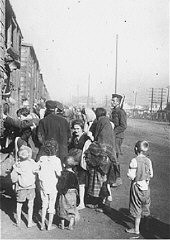
Jews bound for the rail station during deportation action from Sighet. May 18, 1944.
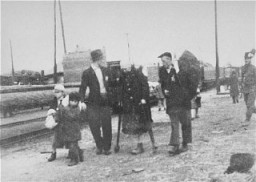
Jewish residents of the Szeged ghetto assemble for deportation. Szeged, Hungary, June 1944.
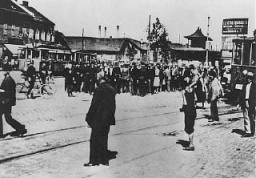
Deportation from the Kovno ghetto to forced-labor camps in Estonia. Kovno, Lithuania, October 1943.
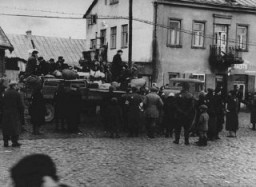
A member of the German SS supervises the boarding of Jews onto trains during a deportation action in the Krakow ghetto. Krakow, Poland, 1941–1942.
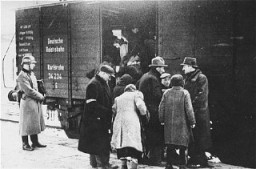
Deportation of Jews from the Lodz ghetto. Poland, August 1944.
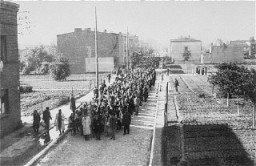
SS personnel stand guard while Lodz ghetto police board Jews onto a deportation train bound for Chelmno or Auschwitz. Lodz, Poland, between May and August 1944.
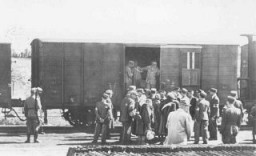
Jewish deportees from Luxembourg, Austria, and Czechoslovakia during deportation from the Lodz ghetto to the Chelmno killing center. Lodz, Poland, 1942.
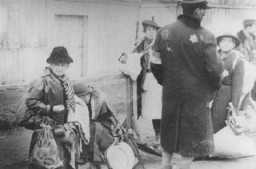
Jewish women and children are transported by horse-drawn wagon during a deportation action in the Siedlce ghetto. During the liquidation of the ghetto on August 22-24, 1942, 10,000 Jews were deported to the Treblinka killing center.
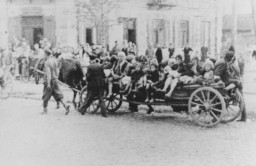
Jews assembled in the Siedlce ghetto during a deportation are forced to march toward the railway station. Siedlce, Poland, August 21–24, 1942.
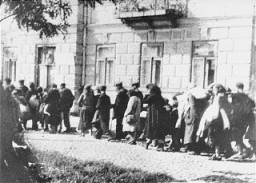
Deportation of Jews from the Warsaw ghetto during the ghetto uprising. The original German caption reads: "To the Umschlagplatz." Warsaw, Poland, May 1943.
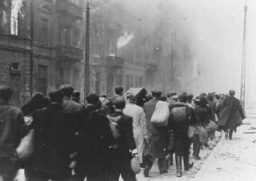
Jews from the Warsaw ghetto are marched through the ghetto during deportation. Warsaw, Poland, 1942–43.

Deportation of Jews from the Warsaw ghetto during the uprising. This photo was taken secretly from a building adjacent to the ghetto by a Polish member of the resistance. Warsaw, Poland, April 1943.
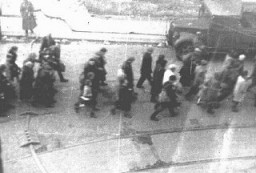
Deportation of Jews from the Warsaw ghetto during the uprising. This photo was taken secretly from a building adjacent to the ghetto by a Polish member of the resistance. Warsaw, Poland, April 1943.
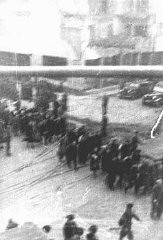
Deportation of Jews from the Warsaw ghetto during the uprising. The photograph was taken from a building opposite the ghetto by a member of the resistance. It shows Jews who were captured by the SS during the suppression of the Warsaw ghetto uprising marching past the St. Zofia hospital, through the intersection of Nowolipie and Zelasna Streets, towards the Umschlagplatz for deportation. Warsaw, Poland, April 20, 1943.
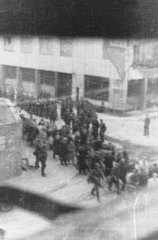
Jews being deported from the Warsaw ghetto board a freight train. Warsaw, Poland, July-September 1942.
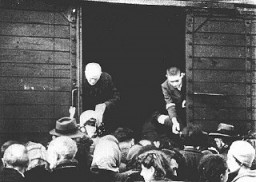
We would like to thank Crown Family Philanthropies, Abe and Ida Cooper Foundation, the Claims Conference, EVZ, and BMF for supporting the ongoing work to create content and resources for the Holocaust Encyclopedia. View the list of donor acknowledgement.